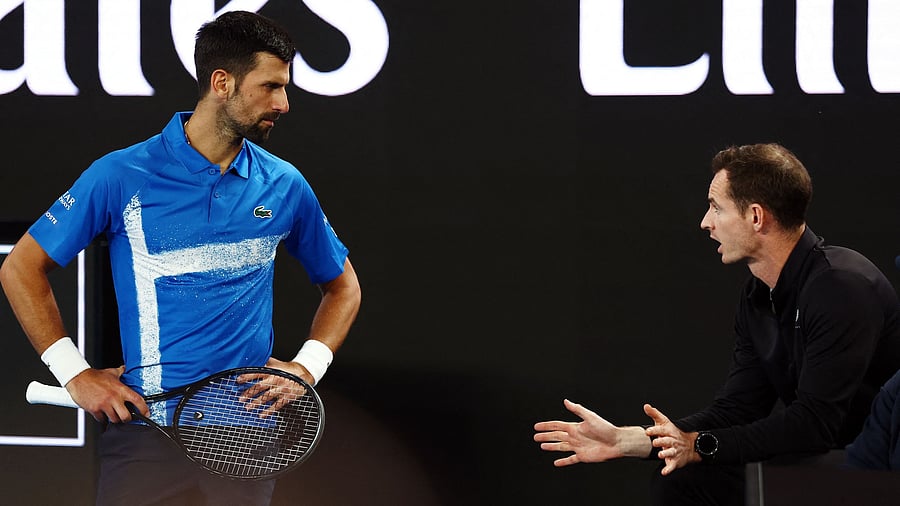
Australian Open - Melbourne Park, Melbourne, Australia - January 13, 2025 Serbia's Novak Djokovic in conversation with his coach Andy Murray during his first round match against Nishesh Basavareddy of the United States.
Credit: Reuters Photo
Bengaluru: 2018: A gesture from coach Patrick Mouratoglou in Serena Williams’ player’s box was deemed ‘coaching’ by chair umpire Carlos Ramos, earning Williams a ‘code violation’ in the US Open final against Naomi Osaka, which the American eventually lost.
2022: “Are you stupid? His father can talk every point? Look at me, I’m talking to you,” yelled an irate Daniil Medvedev at chair umpire Jaume Campistol, accusing Stefanos Tsitsipas of receiving ‘coaching’ during their Australian Open semifinal.
2025: Novak Djokovic, a 24-time Grand Slam champion, is seen having a 30-second chat at the end of the third set (leading 2-1) with coach Andy Murray about strategy during his first-round match against Nishesh Basavareddy. No rebuke comes from the chair umpire.
2025: Former Wimbledon champion Conchita Martínez offers words of advice and animated signals during points and games to guide her protégé, Mirra Andreeva, to victory against Marie Bouzková—again, with no intervention from the chair umpire.
These contrasting scenarios reflect a seismic shift in tennis regarding ‘coaching’ during matches. Once forbidden, on-court coaching has been legalised, dividing the tennis community into three camps: traditionalists who oppose it, neutrals who accept the change, and nonconformists who argue it was long overdue, given its prevalence even when prohibited.
The debate reached a crescendo after the International Tennis Federation (ITF) overhauled the rules in October 2024 to permit on-court coaching at all tournaments starting January 1, 2025.
“This has been in trial form since 2017. People who have been watching the sport, particularly over the last two years, will have seen trials going on across the whole of the professional game including the ITF World Tennis Tour, ATP and WTA Tours and all Grand Slams,” explained Stuart Miller, ITF Senior Executive Director, Integrity & Legal, during the announcement.
The ongoing Australian Open, the first Grand Slam to implement the rule change, has taken player-coach interaction to new heights with the introduction of ‘coaching pods.’ These mini players’ boxes, situated at courtside corners, feature four chairs for support staff and screens displaying real-time stats and data.
But not everyone is thrilled.
“I have never been in favor of on-court coaching,” Vijay Amritraj, Indian tennis great and commentator, tells DHoS.
“Tennis has always been a sport where you do your homework before you get to the court and once you get to the court, it's yours (players) to figure out the problems you may have,” insists the 71-year-old.
Amritraj also highlights the potential inequity the rule creates, favoring top players who can afford full coaching entourages.
“Let’s say someone ranked 150 plays Djokovic. The Serb has access to a full team, while the lower-ranked player doesn’t. Djokovic is better, yes, but you want to ensure he wins based on his talents alone, not extra resources,” he argues.
James Allemby, a coach at the Rafael Nadal Academy, offers a different perspective. According to him coaching during a match has an influence, but it’s marginal.
“..because the majority is down to the player making his own decision in the heat of the moment and having the clarity of thought to apply in a point situation.
“I like it (rule change). It was being done in the lower tournaments anyway. Now it's sort of blurring of the lines where the players couldn't talk to the coaches in big tournaments with massive crowds,” says the British-Canadian, who works with Hong Kong’s world No. 171, Coleman Wong.
Allemby believes the rule change aligns with modern tennis practices, noting it had been trialed in smaller tournaments. He also appreciates the educational value of watching top players interact with their coaches during big matches.
“I enjoy seeing this equation from the outside. What the top players are talking about with their coaches. See the heated exchanges, the players berating their boxes, how the coach responds to that.. It gives such a good insight because then you can see immediately if the player manages to apply what the coach is saying or not.
“For example, a player is asking the coach where to cover on a serve, the coach says one thing but then the opponent goes the other way. To see whether the player blames the coach for the bad decision or whether the player takes the responsibility himself. So, it's interesting,” says Allemby.
The reactions to coaching pods at Melbourne Park have been mixed. Djokovic approves, Stefanos Tsitsipas finds them “weird,” Aryna Sabalenka calls them “too small,” and Alexander Zverev remains skeptical. For Amritraj, the pods’ physical presence isn’t an issue.
“It’s already done in Davis Cup and team events. This isn’t a big adjustment. Getting used to challenging calls was harder than this.”
A significant addition to the pods is live in-match data, providing intricate details like serve locations and stroke patterns alongside basic stats like aces or unforced errors.
“Tennis is entertainment at the end of the day,” Allemby points out. “Live data helps, but the coach’s intuition is still crucial. As they say, statistics are like a bikini—they reveal a lot but not everything.”
While the debate rages, chair umpires have emerged as unexpected beneficiaries. Freed from the responsibility of enforcing coaching violations, umpires are no longer demonised for subjective rulings, as in the cases of Ramos and Campistol.
With this shift, tennis joins other sports that embrace coach-player interaction. Sideline guidance is common in badminton, squash, and table tennis. Football, basketball, and volleyball rely on team input mid-game, while Formula 1 thrives on driver-team radio broadcasts.
Still, tennis has long been celebrated for its one-on-one, gladiatorial contests, where players rely solely on their wits and inner resolve. This change, many argue, shakes the sport’s very core.
Like it or not, tennis is evolving. The future is here.